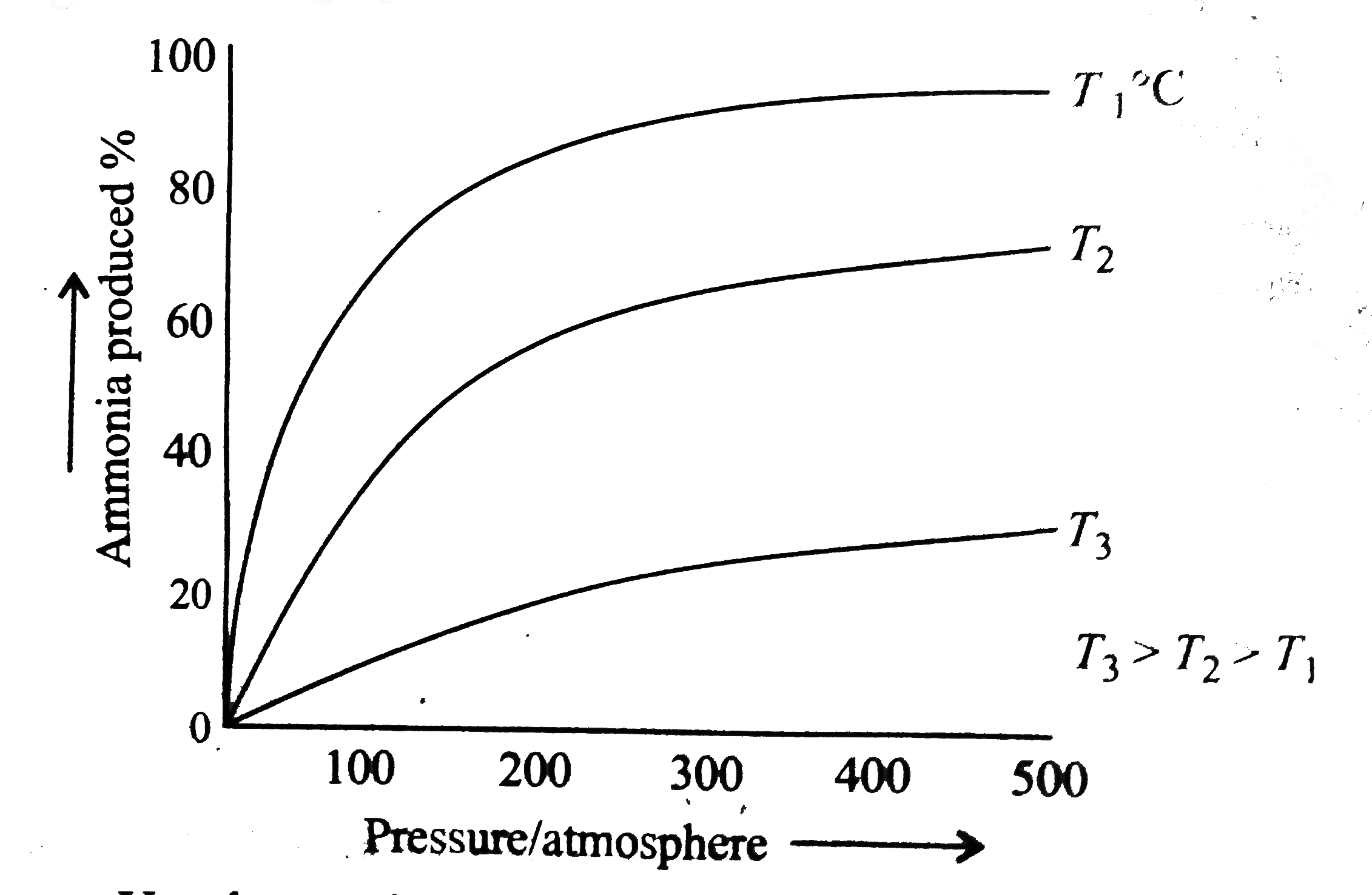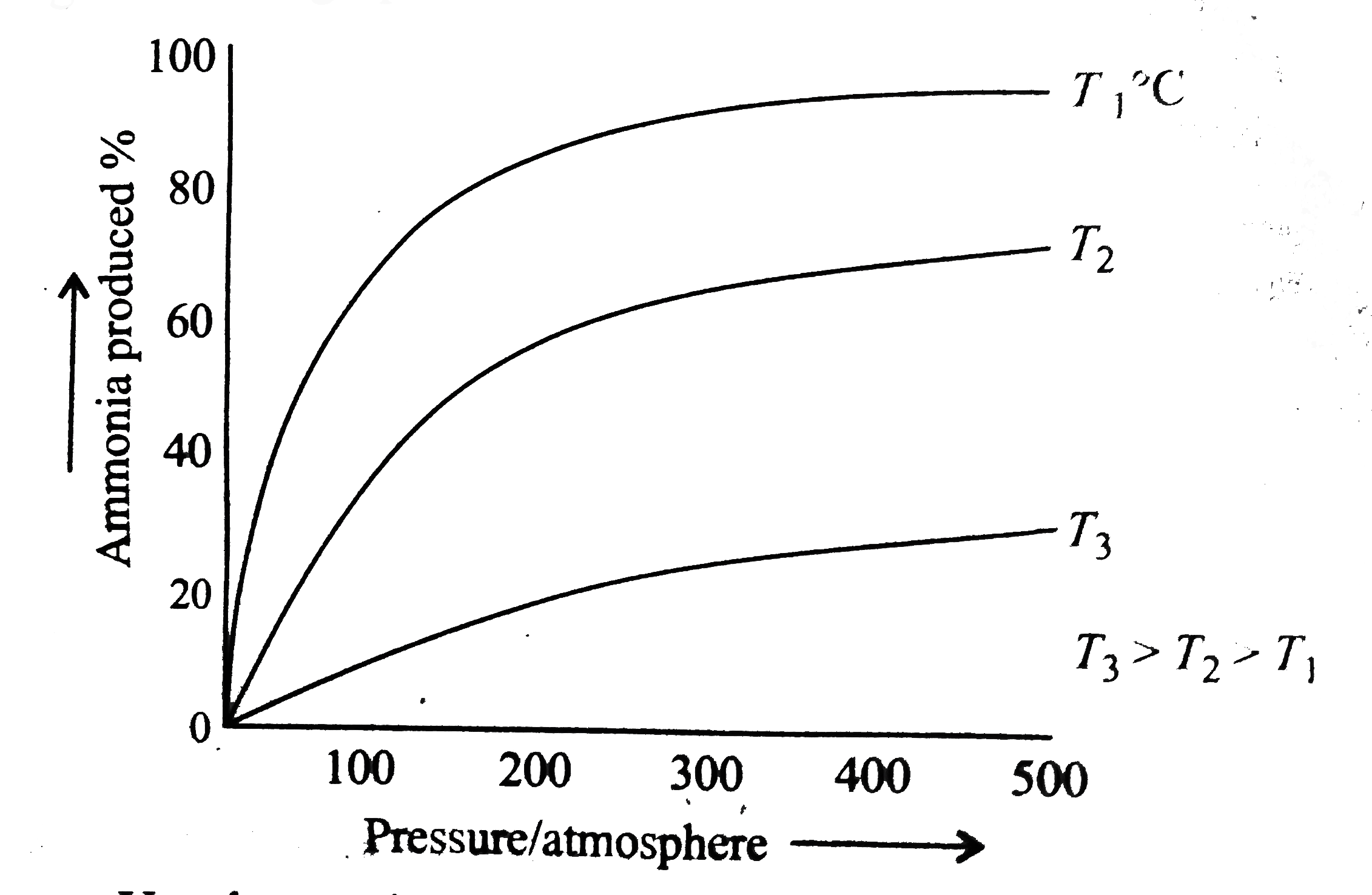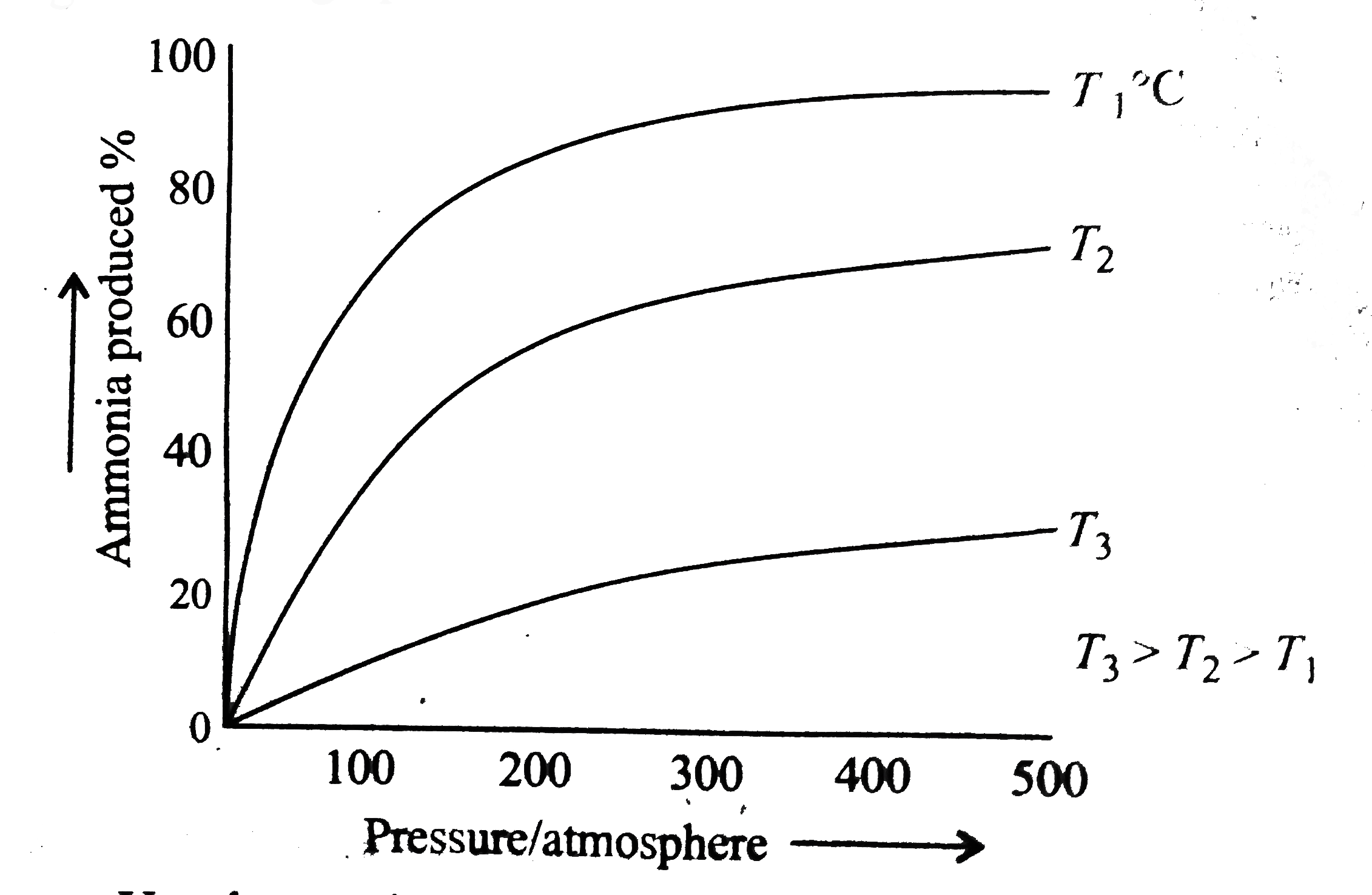Exercises (Linked Comprehensive) from CENGAGE CHEMISTRY (ENGLISH) Chapter 7 CHEMICAL EQUILIBRIUM for Class 11
| Class 11 | CHEMISTRY |
| Chapter | CHEMICAL EQUILIBRIUM |
| CENGAGE CHEMISTRY (ENGLISH) | Exercises (Linked Comprehensive) |
| Medium | English |
| Academic Year | 2023-2024 |
Question 3
Physical and chemical equilibrium can respond to a change in their pressure, temperature, and concentration of reactants and products. To describe the change in the equilibrium we have a principle named Le Chatelier principle. According to this principle, even if we make some changes in equilibrium, then also the system even re-establishes the equilibrium by undoing the effect.
In the reaction N2(g)+3H2(g)⇔2NH3(g). If we increase the pressure of the system, the equilibrium isView SolutionQuestion 4
Consider the chemical reaction:
Ni2+(aq)(Green solution)+6NH3(aq)⇔[Ni(NH3)6]2+(Blue solution)(aq)
When H⊕(aq) is added, the colour green is favoured. Use one or more of the following interpretations to answer the questions:
i. Some unreacted Ni2+(aq) is present in the solution at equilibrium
ii. Some unreacted NH3(aq) is present in the solution at equilibrium
iii. The colour change indicates new equilibrium conditions with reduced [Ni(NH3)6]2+(aq)
iv. The colour change indicates new equilibrium conditions with increased [Ni(NH3)6]2+(aq).
The deepening of blue colour on dissolving more Ni(NO3)2 supports interpretation (s). View SolutionQuestion 5
Consider the chemical reaction:
Ni2+(aq)(Green solution)+6NH3(aq)⇔[Ni(NH3)6]2+(Blue solution)(aq)
When H⊕(aq) is added, the colour green is favoured. Use one or more of the following interpretations to answer the questions:
i. Some unreacted Ni2+(aq) is present in the solution at equilibrium
ii. Some unreacted NH3(aq) is present in the solution at equilibrium
iii. The colour change indicates new equilibrium conditions with reduced [Ni(NH3)6]2+(aq)
iv. The colour change indicates new equilibrium conditions with increased [Ni(NH3)6]2+(aq).
The deepening of blue colour on addition of more NH3(aq) supports interpretation(s).View SolutionQuestion 6
One "mole" of NH4HS(s) was allowed to decompose in a 1−L container at 200∘C. It decomposes reversibly to NH3(g) and H2S(g).NH3(g) further undergoes decomposition to form N2(g) and H2(g). Finally, when equilibrium was set up, the ratio between the number of moles of NH3(g) and H2(g) was found to be 3.
NH4HS(s)⇔NH3(g)+H2S(g),Kc=8.91×10−2M2
2NH3(g)⇔N2(g)+3H2(g),Kc=3×10−4M2
Answer the following:
What is the "mole" fraction of hydrogen gas in the equilibrium mixture in the gas phase?View SolutionQuestion 7
One "mole" of NH4HS(s) was allowed to decompose in a 1−L container at 200∘C. It decomposes reversibly to NH3(g) and H2S(g).NH3(g) further undergoes decomposition to form N2(g) and H2(g). Finally, when equilibrium was set up, the ratio between the number of moles of NH3(g) and H2(g) was found to be 3.
NH4HS(s)⇔NH3(g)+H2S(g),Kc=8.91×10−2M2
2NH3(g)⇔N2(g)+3H2(g),Kc=3×10−4M2
Answer the following:
To attain equilibrium, how much % by weight of folid NH4HS got dissociated?View SolutionQuestion 8
One "mole" of NH4HS(s) was allowed to decompose in a 1−L container at 200∘C. It decomposes reversibly to NH3(g) and H2S(g).NH3(g) further undergoes decomposition to form N2(g) and H2(g). Finally, when equilibrium was set up, the ratio between the number of moles of NH3(g) and H2(g) was found to be 3.
NH4HS(s)⇔NH3(g)+H2S(g),Kc=8.91×10−2M2
2NH3(g)⇔N2(g)+3H2(g),Kc=3×10−4M2
Answer the following:
What is the "mole" fraction of hydrogen gas in the equilibrium mixture in the gas phase?View SolutionQuestion 22
Decomposition of ammonium chloride is an endothermic reaction. The equilibrium may be represented as:
NH4Cl(s)⇔NH3(g)+HCl(g)
A 6.250g sample of NH4Cl os placed in an evaculated 4.0L container at 27∘C. After equilibrium the total pressure inside the container is 0.820 bar and some solid remains in the container. Answer the followings
The value of Kp for the reaction at 300K isView SolutionQuestion 23
Decomposition of ammonium chloride is an endothermic reaction. The equilibrium may be represented as:
NH4Cl(s)⇔NH3(g)+HCl(g)
A 6.250g sample of NH4Cl os placed in an evaculated 4.0L container at 27∘C. After equilibrium the total pressure inside the container is 0.820 bar and some solid remains in the container. Answer the followings
The amount of solid NH4Cl left behind in the container at equilibrium isView SolutionQuestion 24
Decomposition of ammonium chloride is an endothermic reaction. The equilibrium may be represented as:
NH4Cl(s)⇔NH3(g)+HCl(g)
A 6.250g sample of NH4Cl os placed in an evaculated 4.0L container at 27∘C. After equilibrium the total pressure inside the container is 0.820 bar and some solid remains in the container. Answer the followings
If the volume of container were doubled at constant temperature, then what would happen to the amount of solid in the container.View SolutionQuestion 25
Decomposition of ammonium chloride is an endothermic reaction. The equilibrium may be represented as:
NH4Cl(s)⇔NH3(g)+HCl(g)
A 6.250g sample of NH4Cl os placed in an evaculated 4.0L container at 27∘C. After equilibrium the total pressure inside the container is 0.820 bar and some solid remains in the container. Answer the followings
The value of Kp for the reaction at 300K isView SolutionQuestion 26
Decomposition of ammonium chloride is an endothermic reaction. The equilibrium may be represented as:
NH4Cl(s)⇔NH3(g)+HCl(g)
A 6.250g sample of NH4Cl os placed in an evaculated 4.0L container at 27∘C. After equilibrium the total pressure inside the container is 0.820 bar and some solid remains in the container. Answer the followings
The value of Kp for the reaction at 300K isView SolutionQuestion 35
The relation between Kp and Kc is Kp=Kc(RT)Δn unit of Kp=(atm)Δn, unit of Kc=(molL−1)Δn
H3ClO4 is a tribasic acid, it undergoes ionisation as
H3ClO4⇔H⊕+H2ClO−4,K1
H2ClO−4⇔H⊕+HClO2−4,K2
HClO2−4⇔H⊕+ClO3−4,K3
Then, equilibrium constant for the following reaction will be:
H3ClO4⇔3H⊕+ClO3−4View SolutionQuestion 38
N2(g)+3H2(g)⇔2NH3(g),ΔHɵ=−22.4kJ
The pressure inside the chamber is 100 atm and temperature at 300K
The preparation of ammonia by Haber's process is an exothermic reaction. If the preparation follows the following temperature-pressure relationship for its % yield. Then for temperature T1,T2 and T3 the correct option is:
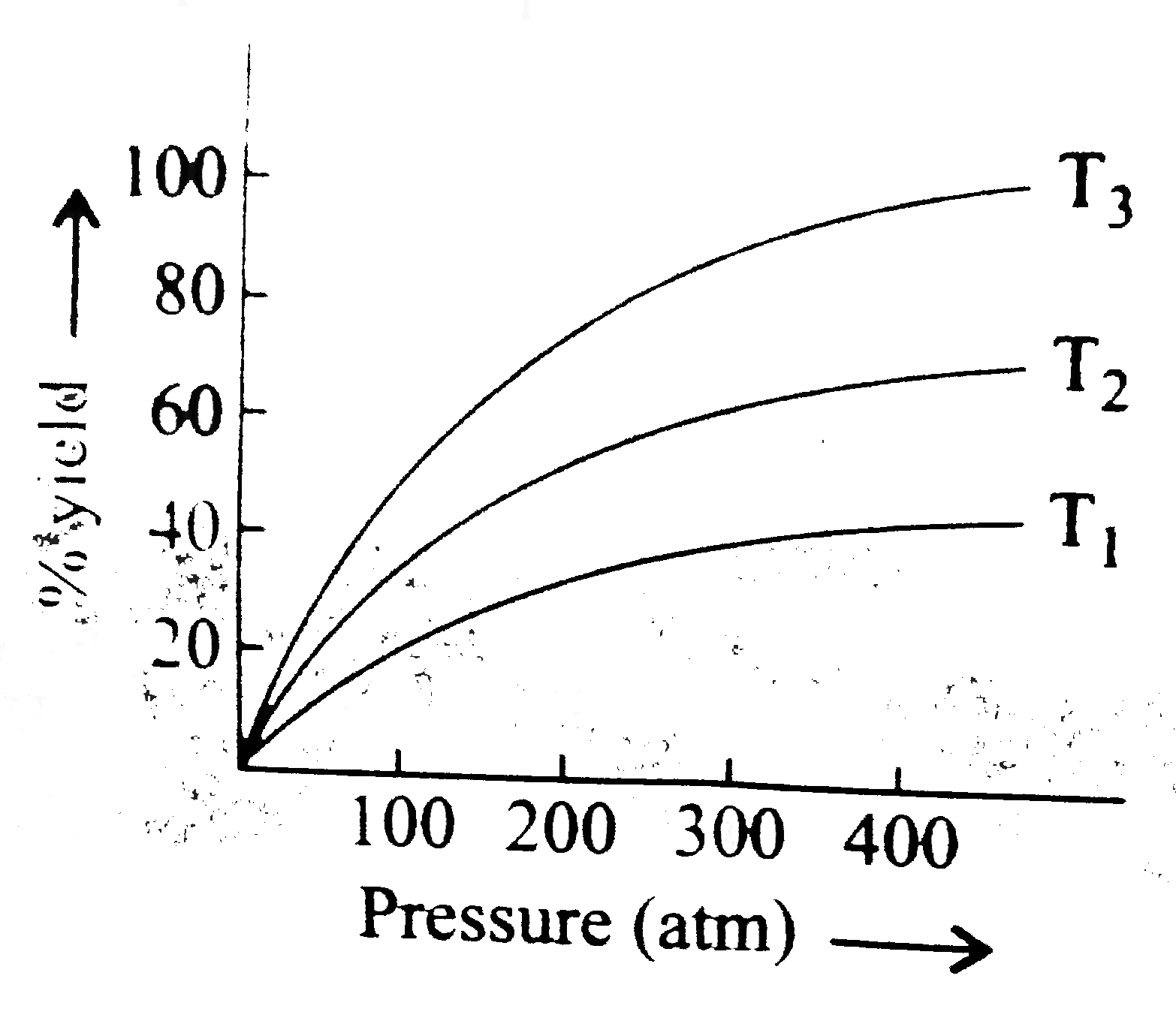 View Solution
View SolutionQuestion 41
Mass action rato or reaction quotient Q for a reaction can be calculate using the law of masss action
A(g)+B(g)⇔C(g)+D(g)
Q=[C][D][A][B]
The value of Q decides whether the reaction is at equilibrium or not.
At equilibrium, Q=K
For an equilibrium process, Q≠K
when Q>K, reaction will favour backward direction and when Q<K, it will favour direction.
Answer the following questions:
The reaction quotient Q for:
O2(g)+2H2(g)⇔2H2O(g)
is given by Q=[H2O]2[O2][H2]2. The reaction will proceed in backward direction, when View SolutionQuestion 42
Mass action rato or reaction quotient Q for a reaction can be calculate using the law of masss action
A(g)+B(g)⇔C(g)+D(g)
Q=[C][D][A][B]
The value of Q decides whether the reaction is at equilibrium or not.
At equilibrium, Q=K
For an equilibrium process, Q≠K
when Q>K, reaction will favour backward direction and when Q<K, it will favour direction.
Answer the following questions:
For the reaction:
2A+B⇔3C at 298K,Kc=40
A 4L vessel contains 2,1, and 4 mol of A, B and c, respectively. The reaction at the same temperatureView SolutionQuestion 43
Mass action rato or reaction quotient Q for a reaction can be calculate using the law of masss action
A(g)+B(g)⇔C(g)+D(g)
Q=[C][D][A][B]
The value of Q decides whether the reaction is at equilibrium or not.
At equilibrium, Q=K
For an equilibrium process, Q≠K
when Q>K, reaction will favour backward direction and when Q<K, it will favour forward direction.
Answer the following questions:
In a reaction mixture containing H2,N2 and NH3 at partial pressure of 2 atm, 1 atm and 3 atm respectively, the value of Kp at 700K is 4.00×10−5atm−2. In which direction the net reaction will go?
N2(g)+3H2(g)⇔2NH3(g)View SolutionQuestion 44
Mass action rato or reaction quotient Q for a reaction can be calculate using the law of masss action
A(g)+B(g)⇔C(g)+D(g)
Q=[C][D][A][B]
The value of Q decides whether the reaction is at equilibrium or not.
At equilibrium, Q=K
For an equilibrium process, Q≠K
when Q>K, reaction will favour backward direction and when Q<K, it will favour direction.
Answer the following questions:
In the following reaction:
2SO2(g)+O2(g)⇔2SO3(g)
the equilibrium is not attained. The rate of forward reaction is greater than that of backward reaction. Thus, which of the following is the correct relation between Kp and Qp?View SolutionQuestion 45
Mass action rato or reaction quotient Q for a reaction can be calculate using the law of masss action
A(g)+B(g)⇔C(g)+D(g)
Q=[C][D][A][B]
The value of Q decides whether the reaction is at equilibrium or not.
At equilibrium, Q=K
For an equilibrium process, Q≠K
when Q>K, reaction will favour backward direction and when Q<K, it will favour direction.
Answer the following questions:
In the reaction:
NH4Cl(g)⇔NH3(g)+HCl(g)
a graph is plotted to show that the variation or the rate of forward and backward reaction against time.
Which of following is correct?
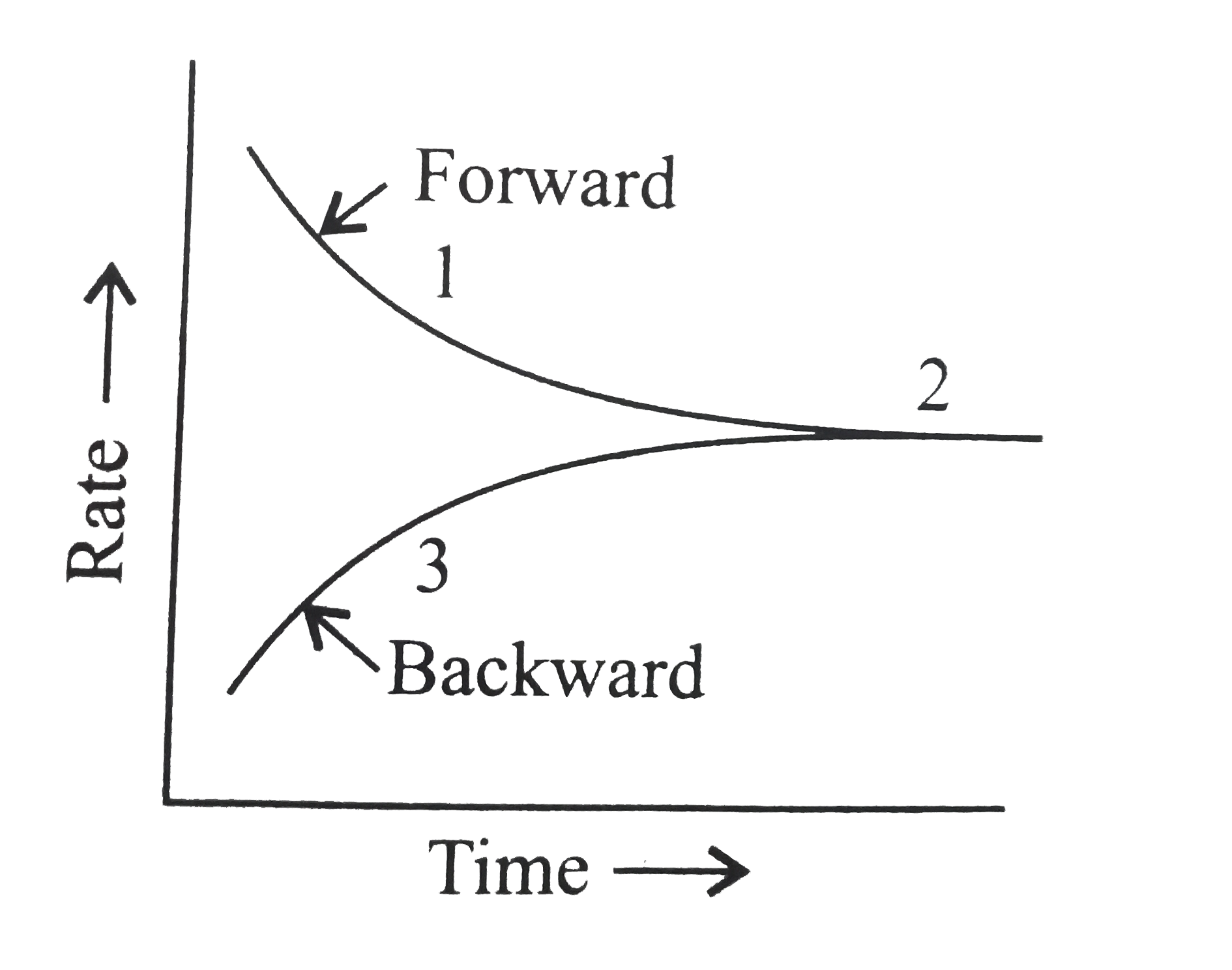 View Solution
View SolutionQuestion 46
Dehydration of salts is an important class of heterogeneous reactions. The salt hydrates during dehydration often dissociate in steps to form a number of intermediate hydrates according to the prevailing pressure of moisture in contact with the solid hydrates. Thus, copper sulphate pentahydrate on dissociation yield trihydrates, monohydrates and then the anhydrous salt in the above order as follows:

The equilibrium constant Kp for the equilibrium between pentahydrate and trihydrate is:View SolutionQuestion 47
Dehydration of salts is an important class of heterogeneous reactions. The salt hydrates during dehydration often dissociate in steps to form a number of intermediate hydrates according to the prevailing pressure of moisture in contact with the solid hydrates. Thus, copper sulphate pentahydrate on dissociation yield trihydrates, monohydrates and then the anhydrous salt in the above order as follows:

The ratio of equilibrium constant between pentahydrate and trihydrate and equilibrium between trihydrate and monohydrate isView SolutionQuestion 48
Dehydration of salts is an important class of heterogeneous reactions. The salt hydrates during dehydration often dissociate in steps to form a number of intermediate hydrates according to the prevailing pressure of moisture in contact with the solid hydrates. Thus, copper sulphate pentahydrate on dissociation yield trihydrates, monohydrates and then the anhydrous salt in the above order as follows:

Which of the following conditions is favourable for dehydration of CuCO4.5H2O?
i. Low humidty in air
ii. High temperature
iii. pH2O increases
The correct option is:View SolutionQuestion 51
X, Y and Z react in the 1:1:1 stoichiometric ratio.
The concentration of X, Y and Z we are found to vary with time as shown in the figure below:

If the above equilibrium is established in a 2.0L container by taking reactants in sufficient amount then how many moles of components Y must have reacted to establish the equilibrium?View SolutionQuestion 52
Two solids X and Y dissociate into gaseous products at a certain temperature as follows:
i. X(s)⇔A(g)+C(g) and
ii. Y(s)⇔B(g)+C(g)
At a given temperature, pressure over excess solid 'X' is 40 mm of Hg and total pressure over solid 'Y(s)' is 60 mm of Hg.
Now, answer the following questions:
Ratio of Kp for reaction (i) to that of reaction (ii), is:View SolutionQuestion 53
Two solid X and Y dissociate into gaseous products at a certain temperature as followas:
X(s)⇔A(g)+C(g) , and Y(s)⇔B(g)+C(g)
At a given temperature, the pressure over excess solid X is 40mm and total pressure over solid Y is 80mm. Calculate
a. The value of Kp for two reactions.
b. The ratio of moles of A and B in the vapour state over a mixture of X and Y.
c. The total pressure of gases over a mixture of X and Y.View SolutionQuestion 54
Two solid X and Y dissociate into gaseous products at a certain temperature as followas:
X(s)⇔A(g)+C(g) , and Y(s)⇔B(g)+C(g)
At a given temperature, the pressure over excess solid X is 40mm and total pressure over solid Y is 80mm. Calculate
a. The value of Kp for two reactions.
b. The ratio of moles of A and B in the vapour state over a mixture of X and Y.
c. The total pressure of gases over a mixture of X and Y.View Solution
All Exercises from CENGAGE CHEMISTRY (ENGLISH) Class 11 CHEMISTRY CHEMICAL EQUILIBRIUM
- Archives (Fill In The Blanks)
- Archives (Multiple Correct)
- Archives (Single Correct)
- Archives (Subjective)
- Archives (True/False)
- Concept Applicationexercise 7.1
- Ex 7.2
- Exercises (Assertion-Reasoning)
- Exercises (Fill In The Blanks)
- Exercises (Integer)
- Exercises (Linked Comprehensive)
- Exercises (Multiple Correct)
- Exercises (Single Correct)
- Exercises (Subjective)
- Exercises (True/False)
- Solved Example
- Subjective type
